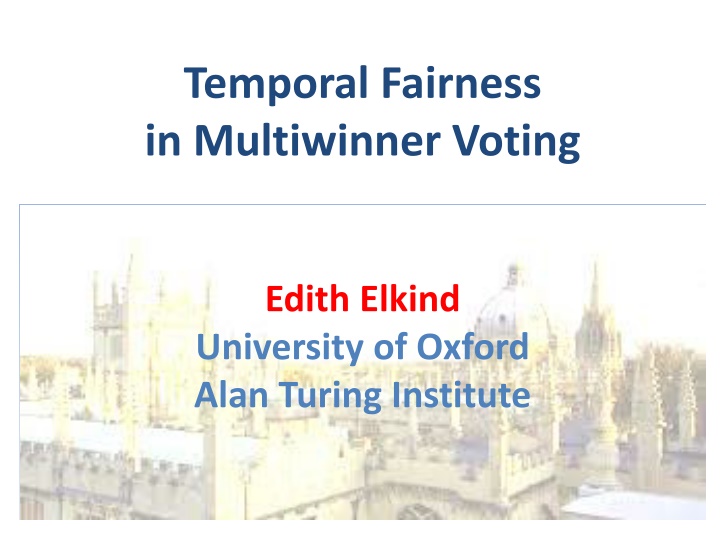
Enhancing Decision-Making in Multiwinner Voting Scenarios
Explore the concepts of temporal fairness in multiwinner voting, the process of selecting governing bodies, appointing conference chairs, planning holidays, and modeling voting over time. Discover the goals and considerations for formal modeling in such scenarios for better outcomes.
Download Presentation

Please find below an Image/Link to download the presentation.
The content on the website is provided AS IS for your information and personal use only. It may not be sold, licensed, or shared on other websites without obtaining consent from the author. If you encounter any issues during the download, it is possible that the publisher has removed the file from their server.
You are allowed to download the files provided on this website for personal or commercial use, subject to the condition that they are used lawfully. All files are the property of their respective owners.
The content on the website is provided AS IS for your information and personal use only. It may not be sold, licensed, or shared on other websites without obtaining consent from the author.
E N D
Presentation Transcript
Temporal Fairness in Multiwinner Voting Edith Elkind University of Oxford Alan Turing Institute
How to Select Your Governing Body IFAAMAS: 27-member board 9 members replaced every 2 years approval voting variable set of voters
How to Appoint Conference Chairs IJCAI board of trustees, AAAI conference committee of the Executive Council Task: select PC chair(s) and general chair Need to represent diverse research areas and geographic regions respect gender balance short-term and long-term no one serves twice
How to Plan Your Holiday Simpsons go on a 3-day holiday Activities: water park zoo museum shopping What should they do each day?
Preferences Day 1 Day 2 Day 3
Voting Over Time Decisions made repeatedly over time elections for governing bodies event organisation Basic model: set of rounds T set of voters Nt set of projects/candidates Pt in each round, each voter in Nthas preferences over Pt
Modeling Dimensions Outcome: single vs multiple winners in each round duration of service Availabilities/preferences static vs evolving Online vs offline Desiderata individual vs group satisfaction Satisfaction in each round vs for each prefix vs cumulative vs periodic
This Talk: Formal Model n voters, set of m projects P, l rounds In each round, voters express approval preferences over P: si, r P In each round, a single project is selected Outcome: schedule = ( l ) This work: each project is selected at most once i jfor i j Assume: all preferences are given in advance Assume: no strategic behavior
Goals Voter s utility from an outcome: # of rounds where they approve the selected project: ui( ) = |{r [l]: r si, r}| We may want to maximize: sum of utilities (utilitarian SW) min utility (egalitarian SW) We may want to ensure: Pareto optimality Fairness notions
outcome 1 H:0, M:1, B:1, L:2 outcome 2 H:0, M:1, B:2, L:2 outcome 3 H:1, M:1, B:2, L:1
Hard and Easy Problems Util vs egal welfare: which one is harder? Observation: utilitarian welfare maximization is poly-time Proof: we are matching projects to rounds weight of an edge: number of approvals we want a max-weight matching (easy) projects rounds who likes p at r? p r
Complexity of Egalitarian Welfare Theorem: egalitarian welfare maximization (EWM) is NP-hard But what if m, n, or lis small ? Easy for small m (FPT) or l (XP) Theorem: for 2 agents EWM is at least as hard as Exact Matching bipartite graph, each edge is red or blue is there a perfect matching with exactly K red edges? admits a randomized poly-time algorithm not known if there is a deterministic one
Good News Positive result: a randomized algorithm for egal SW maximization and other hard problems, e.g., Pareto optimality Runtime: polynomial in (m+1)n polynomial for a small number of agents Approach: iterate through all (m+1) n utility profiles check if a given utility profile is achievable Technical tool: polynomial identity testing
Warm-up: Edmonds Matrix 0 x1, 2 0 0 x1, 4 0 0 x2, 1 0 0 0 0 AG 0 0 0 0 x3, 5 0 x4, 2 0 x4, 4 0 0 x5, 3 0 G: balanced bipartite n x n graph det(AG): polynomial over n2 vars G
Determinant of the Edmonds Matrix 0 x1, 2 0 0 x1, 4 0 0 x2, 1 0 0 0 0 AG 0 0 0 0 x3, 5 0 x4, 2 0 x4, 4 0 0 x5, 3 0 Fact: det(AG) is not identically 0 iff G admits a perfect matching G Testing algorithm: draw xi, j randomly from a large finite field, evaluate det(AG)
Extension: Schedule Matrix Assume m = l (wlog) a(i, p, r) = 1 if i approves p at r weight of edge (p, r): xp, r yn+1if no one approves p at r xp, r y1a(1, p, r). yna(n, p, r) otherwise Schedule matrix S: (wp, r ) p P, r [l] det(S): determinant of S p r wp, r =
Determinant of the Schedule Matrix xp, r yn+1 if no one approves p at r wp, r = xp, r y1a(1, p, r). yna(n, p, r) otherwise det(S): sum of monomials of the form C(x) y1u(1). ynu(n) yn+1u(n+1) This monomial is not identically zero iff there exists a schedule that guarantees utility u(i) to agent i, and contains u(n+1) useless periods
Computing Determinants How do we check that a particular monomial appears in det(S)? det(S): m2 x-variables and n y-variables Symbolically compute det(S)? using the formula: m! terms Gaussian elimination (or similar): exp over #indeterminates Alternative approach: draw x randomly: det(S(x , y)) is a function of y1, , yn+1 evaluate by polynomial interpolation
Further Work Also in the paper: importing fairness notions from the fair division literature equitability, proportionality (up to k slots) Group fairness (justified representation etc): BHPRT 21, CGP 24, EOT 24 Future work projects with non-unit duration better dependence on n?
